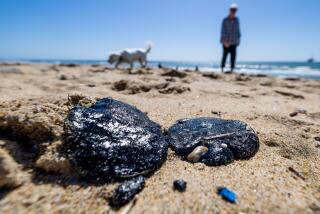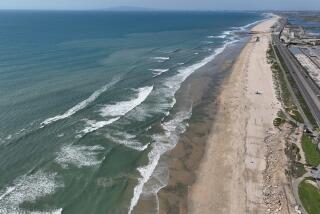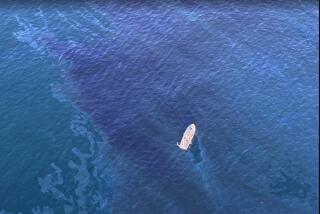No evidence of spilled fuel from grounded Alaska oil rig
An offshore drilling rig remained beached on a remote island in southern Alaska Tuesday, but authorities said there was as yet no evidence that it had leaked any of the more than 150,000 gallons of fuel and other petroleum products on board into the pristine waters nearby.
“Right now … the Kulluk [rig] is sound. There is no sign of a breach of the hull; there is no sign of release of any product,” U.S. Coast Guard Capt. Paul Mehler, the federal on-scene commander for what is becoming a major response effort, said at a news conference.
The 266-foot, conical rig, which recently completed an inaugural season drilling the beginnings of an exploratory well for Shell in the Beaufort Sea, was rocking slowly in the turbulent surf off Sitkalidak Island, near a remote area known as Ocean Bay, just off southern Kodiak Island.
Officials with the Alaska Department of Environmental Conservation said environmental response teams were moving in from as far as Homer and Seward to monitor any potential threats to the water or wildlife.
The area lies near critical habitat for Steller sea lions, protected under the federal Endangered Species Act, and is also near habitat for seabirds known as Steller’s eiders and a number of salmon species, state officials said.
“Today we have no indications of environmental or wildlife impact. And this is based through the continued hard work of the many hundreds of response personnel who have come from around the world,” said Steve Russell, an official with the Department of Environmental Conservation and the state’s incident response commander.
The Kulluk was being towed south from Dutch Harbor, Alaska, last week when both its main tow line and emergency line detached from the vessel hauling it as a result of heavy winds and high seas. The problem was compounded when the engines failed on the towing vessel, and several other attempts to reestablish a tow were also confounded by the heavy weather.
Though the crew of the Kulluk was evacuated over the weekend, the stormy seas continued to pose a threat, and a decision was made Monday night to drop the last tow line holding the Kulluk in place. Within 45 minutes, it drifted toward land and hit ground about 9 p.m. Monday.
Initial overflights Tuesday morning did not reveal any signs of leakage, but Mehler said officials planned to try to land salvage crews on the vessel to examine it closely to determine the extent of any damage.
That was attempted twice on Tuesday, but could not be accomplished because of winds continuing to gust up to 80 mph and seas of more than 40 feet, Mehler said. It has become “No. 1 priority” for Wednesday morning, he said.
“There is still a lot of work to be done to bring this to a safe conclusion,” Shell Exploration’s operations manager, Sean Churchfield, told reporters.
Conservation groups said the incident raised questions about how well Shell Alaska could have responded if the incident had happened not near Kodiak, where the Coast Guard operates a major base, but 1,000 miles north where drilling operations were underway in the Arctic.
“We are learning, again and again, that Alaska’s seas are unforgiving. More careful preparation and planning clearly are needed before decisions are made to allow offshore oil and gas activities in the Arctic Ocean,” the conservation group Oceana, which has opposed offshore drilling in Alaska, said in a statement. “Substantial public resources have been—and will be—expended as a result of Shell’s choices. The American public deserves to know how those choices were made and whether accidents like this can be prevented.”
More to Read
Sign up for Essential California
The most important California stories and recommendations in your inbox every morning.
You may occasionally receive promotional content from the Los Angeles Times.










